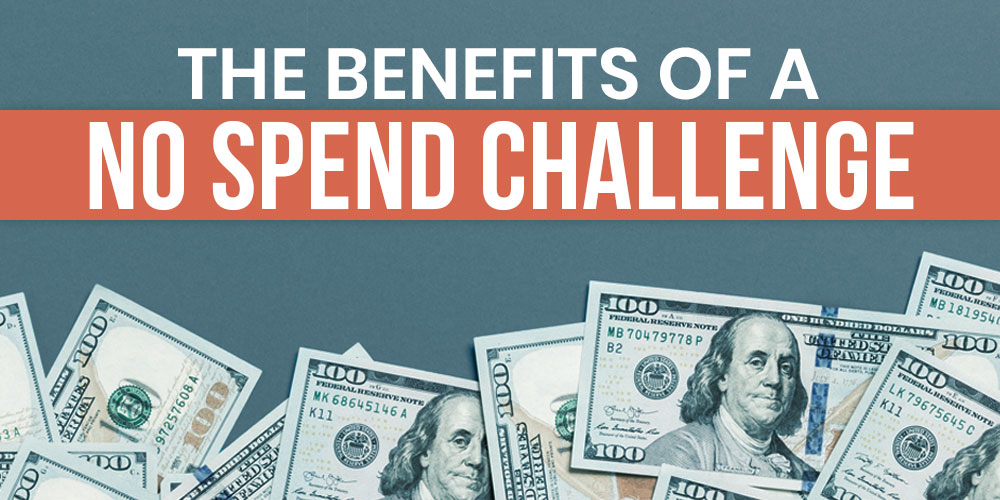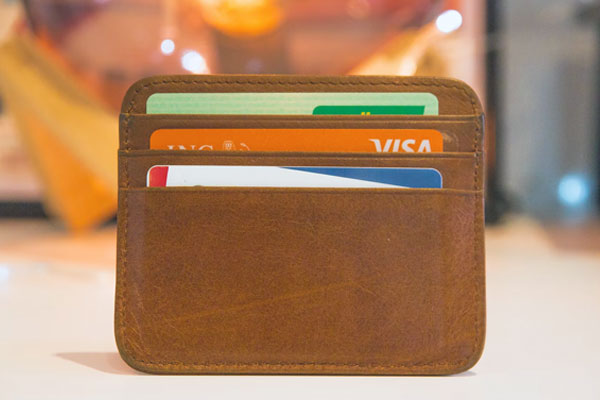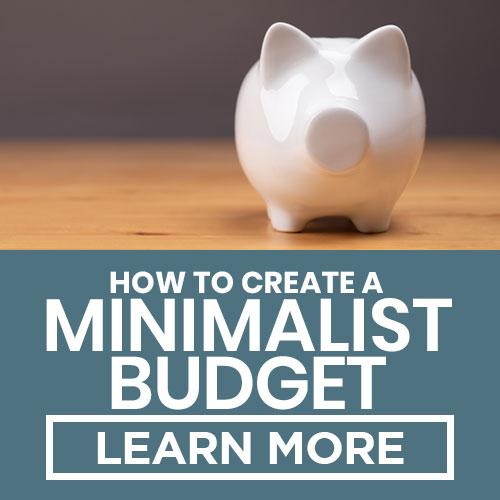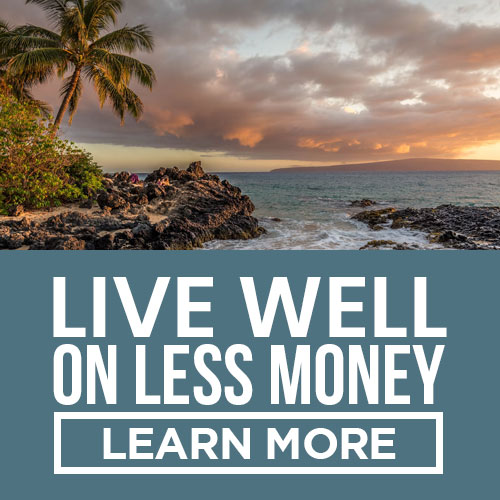
NAVIGATION
In a world where everything costs far more than it should, doing the no spend challenge may sound difficult at first. However, trying the no spend challenge for myself was easier than I expected and helped me reframe the way I think about money habits.

Hi, I’m Ryan
Spending virtually nothing for an entire year truly changed my relationship with money and helped me to rework my spending habits even after my no-spend year ended.

What Is The No Spend Challenge?

In a nutshell, the no spend challenge encourages you to spend almost nothing for an entire week, month, or year, on anything but life necessities. This challenge is different from the low buy year, which encourages you to spend less, but not nothing.
 To be honest with you, the no spend challenge sounded incredibly tough at first. Even though I live in a tiny house and follow a mostly minimalist lifestyle, the thought of buying absolutely nothing for a stretch of time was a lot to consider.
To be honest with you, the no spend challenge sounded incredibly tough at first. Even though I live in a tiny house and follow a mostly minimalist lifestyle, the thought of buying absolutely nothing for a stretch of time was a lot to consider.
However, the challenge ended up going a lot more smoothly than I initially expected. I chalk a great deal of this up to my mindset during my no spend year.
The no spend challenge isn’t meant to stop people from spending money because it’s somehow bad or wrong to buy what you want — there’s nothing wrong with shopping itself. It’s all about the thought process behind the spending.
Buying becomes a problem when we spend money we don’t have on items we don’t need. Sometimes, we expect our purchases to bring us happiness, friends, freedom, or other rewards they can’t possibly deliver. The no spending challenge helped me overcome this.

Why I Decided To Try The No Spend Challenge


My reasons for doing a no spend challenge had a lot to do with my own personal life goals. Spending money on extraneous items was holding me back from accomplishing my biggest goals and creating a barrier between myself and the life I wanted.
Once I realized my “why,” keeping myself focused on my no spend challenge became much easier. No way am I going to pass up my big dreams for a temporary convenience or splurge. Spending money now in lieu of a bigger, better future just isn’t worth it.
What Is Allowed During A No Spend Challenge?


Know that the no spend challenge doesn’t require you to spend absolutely zero dollars, that would be next to impossible. There are things you need to live that would be a little more than crazy to sacrifice, just for the sake of living like a minimalist.
The goal of the no spend challenge is to help you reframe your relationship with the way you spend money by testing if you truly need the things you buy.
Here’s what is and isn’t allowed when doing the challenge
What You CAN Buy
- Food
- Medication
- Daily necessities (toilet paper, toothpaste, shampoo, etc.)
- Gas / transportation (walk where you can!)
- Bills (phone, rent, car insurance)
What You CAN’T Buy
- Fast food / coffee shops / going out to eat
- Entertainment devices / physical books
- New clothes or impulse purchases
- Hair or nail services
- Amazon orders / streaming services
How Long Should A No Spending Challenge Last?


The length of the no spend challenge is ultimately up to you. Some people do this challenge for up to a year, like me, while others get just as much value out of trying it out for only one week or a weekend!
Trying A No Spend Year
When I did the no spending challenge on my own, I started out with six months then decided to keep it rolling for the full year. As the months progressed and I got more of a handle on what the no spending lifestyle felt like, I knew I could stick it out.
I personally really liked doing this challenge for an entire year because it gave me a chance to face a good challenge, learning a lot about myself and my habits over the course of that year.
What A No Spend Month Looks Like
Doing a no buy month instead of a no spend year is an awesome middle ground when it comes to taking on this challenge. A month is an ideal amount of time to dive fully into the lifestyle for a solid amount of time, without the daunting timeline of a full year. The no spend month challenge is probably the most popular choice for beginners.
Trying A No Spend Week
If you’re looking for a quick taste of the no spend challenge without too much commitment, trying a no spend week or no spend weekend might be the move for you. Doing a no spend week every so often is also an easy habit to get into, because you can dive all in every so often without giving up a ton of time to the challenge.
How To Do A No Spend Challenge: Rules I Followed


I’m not a huge fan of strict lifestyle rules, to be honest. Still, when it came to the no spending challenge, I wanted to set up guidelines and parameters. I knew I had to clearly define the rules so I couldn’t exploit any loopholes.
Food Isn’t Part Of The No Spend Challenge
Everyone needs to eat, and refraining from spending money on food would be near impossible. Even if you were to grow your own food, you’d have to spend money on supplies. As part of the no spend challenge, I cut out all fast food and only allowed myself to eat out at sit-down restaurants on extra special occasions. The no spend challenge encouraged me to cook a lot more.
You Can Buy Daily Necessities
Consumable products are another necessity you’re totally allowed to spend on (like toilet paper and toothpaste). To make sure I didn’t find a way to exploit this no spend rule, I created an “inventory” before I started. I only allowed myself to keep those items and not add to the inventory list.
You Can Spend On Medicine
Prescription medications or other doctor-recommended spends are obviously allowed. You can also get over-the-counter medicine like pain or allergy relief, or herbal remedies if that’s your thing. As a rule, this situation hasn’t yet come up, because I’ve been lucky enough to stay healthy.
Still, health is too important to not add this caveat. Of course, this part of the challenge will be different for everyone depending on their own personal medical needs.
Fix First, Replace Second
All I really have in my house are necessities, which means if something breaks, it’s an item I truly need and can’t just get rid of when it breaks. When doing the no spend challenge, I set a rule for myself to try to fix broken items first, then if I couldn’t, I was allowed to replace it.
Read Digital Books With No Spend Challenge
This was one of the hardest rules for me to follow over the course of my year without spending. I love reading and do a lot of it, and one of my main perpetual goals is to read at least two books a month.
When doing the no spend challenge, I downloaded audiobooks to my phone. If I wanted a physical book, I used the library.
Helpful Tips When Trying The No Spend Challenge


Even as a pretty avid minimalist, I found the no spending challenge to be, well, exactly that: a challenge. While the daily ins and out of minimalist living encourages you to live with less, buy less, and get rid of what’s not really necessary, not buying anything at all is a totally different ballgame.
Keeping these tips in mind helped me stay on track during my no spend year. I also think that these five tips can still apply to your life even after your no spending challenge is up.
Remember The Why Behind No Spend Days


As I mentioned before, keeping in mind your reason for trying the no spend challenge as you endure the process will be vital to keep your morale up and refrain from giving up.
Again, the no spend challenge isn’t about getting people to stop buying for a year because buying is bad. It’s about implementing plans and purchases to ultimately make your life better. If an item doesn’t make your life better or move you toward your larger purpose, then it’s probably not worth the money.
Ask Yourself
- Why do I want to take on a no spend challenge?
- What are my larger goals?
- How will this challenge move me toward the goals I want to achieve?


Ask Yourself What You Can Afford


The world of credit has skewed our view on what we can and can’t afford. At the end of the day, if you don’t have the money right now, don’t buy. It’s that simple.
If you’re facing a need you can’t afford, look at the other areas where you spend beyond your means. Are you renting a space that costs more than you can afford? It may be time to move or downsize. If your grocery bill seems exorbitant, try out different money-saving methods like shopping only for items on sale or using coupons, and always build your list around what you already have.
Use A No Spend Tracker
![]()
![]()
Using a no spend expense tracker can be a very helpful tip to keep an honest account of your progress. With any kind of new challenge, whether it be a diet, fitness plan, or no spending challenge like this one, it’s easy to fall into the trap of lying to ourselves about how we’re doing.
![]()
![]()
A great way to combat positivity bias is to use hard data to refute any skewed perception about our progress. A no spending expense tracker keeps up with exactly how much you’ve spent and can be your new best friend.
Delay Your Gratification


Intentionally delaying my gratification with a list of items to buy later was one of the best things I did when I tried the no spending challenge, and it’s still a practice that helps me manage my finances today. Basically, every time you feel the need to make a purchase, instead of rushing to the store, just write it down.
Keep your list with you and reference it the next time you make a trip to the store. The majority of the time, the urge to buy will pass before you even go back. This approach works with online shopping too. Whenever you want an item, add it to your cart and leave it there. Then the next time you shop, if you still want the item, it’s there and ready.
Spend Less While Still Satisfying Your Needs


However, many of our other purchases — clothes, decorations, exercise equipment, appliances — we buy because we’re purchasing an ideal or concept that isn’t actually a necessity. When you decide to buy something new, ask yourself: What am I trying to satisfy by spending? Oftentimes we purchase before exploring alternatives like neighborhood exchange pages or thrift stores.
What I Learned After Not Spending For One Year


Overall, I think one of my biggest takeaways from doing the no spend challenge for a year was all of the room I still have to grow in my own minimalist journey. It surprised me how susceptible I still am to the hype of consumerism, even after being a minimalist for more than 10 years.


At the end of the no spend challenge, I was genuinely glad I didn’t buy the things on my list. My only splurge after waiting for the challenge to be over was a nice pocketknife for all my homesteading and off-grid adventures.
Your Turn!
- What stories have you told yourself when you bought something you didn’t need?
- What things will you refrain from buying while doing this challenge?









Hi Ryan, I have always been “frugal” and the rule I live by and have taught my kids and others is this. before you buy don’t look at the price as much as ask yourself how many hours need I work to buy this item? It works every time.I have never been a part of this mass consumerism and find it revolting. I love your newsletter and videos. I am well on my way to buying my THOW and achieving my Tiny House lifestyle. Good luck in all you do and for reaching your goals
I don’t ask myself how many hours I need to work. That can be deceiving. When you subtract your weekly necessities from your weekly income, you are left with a small amount that is your surplus. Divide the surplus by 40. That is how much you make per hour that can be allotted to extras. Life-changing to discover that I would have to work 2 weeks to pay for a trip to the hairdresser.
With a few tweaks, I could live that lifestyle indefinitely 😉
I work at a library, and we also offer streaming video, downloadable audio and ebooks for our patrons to check out with their library card. The majority of libraries also have digital collections. I thought I would mention this just in case your library has it too.
My dad recommended this article to me. I’m glad he did and it’s going to keep me thinking. I can attest to the delaying gratification section, I always give myself a day or two to mull over an items’ genuine usefulness in my life.
I went through a period where money was pretty tight & I was a few years from getting social security, so I didn’t buy anything I didn’t need. A bike shop refurbished & gave away bikes to people who needed them & since I didn’t want a car, I acquired a bike. For socializing we went for bike rides or walks, had potlucks (again, gotta eat!), etc.; so it was pretty easy. But then, I’ve always been a minimalist: just ask my ex-husband, who was always very materialistic.
The food category is the most confusing and illusive part of this concept to me.
For example, if you take the concept of not spending anything, but you have to eat, but overlaying that with only buying things you need then does this mean you only buy the food you need? Does this mean no spices, no dessert, no condiments? If the answer is yes, then I would challenge back and ask, “Do you really need that?” You stated we all need food, so it’s non-negotiable, but it wasn’t defined regarding what within the food category is needed.
This obviously could then spill out to other categories then too. Do you really need shampoo and conditioner? Do you really need a car instead of taking the bus or using Uber or a bike? Do you really need more than one pair of underwear if you could just wash it every day?
These are the types of questions I find myself asking when I read about a concept like this. Because the rules become grey.
Jesse – this is exactly the thing I’ve been struggling with on my journey to live a minimalist lifestyle – perishables management.
Since overhauling all of my non-perishable items (I got rid of about 2/3 of my wardrobe, sold off $700 worth of stuff at a yard sale, re-evaluated what was left, added more to the get-rid-of pile, and then donated it all) food was the one thing that still made me anxious when I looked at the clutter.
So, here’s what I’ve been doing: I’ve been slowly whittling away at the food on my shelves and NOT buying any more of anything that could live outside of a fridge until I’ve used what I had, and determined that I do actually need another of what I used. There has been a LOT I decided not to purchase again when I initially bought the item I thought I needed, like pancake mix and syrup, because I don’t enjoy making them.
But that’s part of the gray area I had to define on my own. I can buy only what I need to survive every day, but I’d be stressed out every day thinking about when I could get to the store. So I plan for what I’ll eat in a week, then supplement what I don’t already have at the store keeping in mind how long it’ll take me to use what I buy. If it’ll sit around for 2 weeks, I better re-evaluate buying it, because that’s the rule I gave myself.
Given Ryan’s general guidelines and employing a few more definitive rules of your own, the gray area of food can become something well maintained once you know your rules a little better. For me, it’s certainly been a challenge not to buy a ton of junk food — I love chips — but I don’t “need” them, so I limit myself to purchasing a bag every few months.
My goal is to have less food waste and eat healthier (which, yes, does include spices and condiments, for me), so my gray area continues to be molded to work toward those goals, which will continue to be a work in progress for a while yet.
Hey Sarah,
My wife and I would live what I’d consider a minimalist lifestyle. In April, we traded in my 1,400 sq. ft. 3 bedroom 2.5 bath house for a 1 bedroom 400 sq. ft. apartment. We previously had roommates, but the process of downsizing to such a situation was very difficult, yet cleaning.
My wife was initially the one that was most intrigued in trying the no spend challenge. Yet, I didn’t think it was something that we would enjoy because of the ‘whys’ we needed to answer.
For example, it would mean no desserts, no-spend date nights, no-spend travel/vacations, and no-spend fitness.
These are all things my wife and I equally enjoy any enriches our relationship and individual happiness. Yet, when we look at the crux of the exercise it’s about downsizing to needs. Which means, we don’t need dessert, we don’t need to go out to dinner, we don’t need to travel, we don’t need to travel to or have a gym membership; but we do.
Which brings up all sorts of philisophical questions like, “If you don’t need dessert then what is the reward for eating healthy and what is considered a treat?”
“If you don’t need to travel, or want to do it with no-spend, how do you ever see family or get perspective or have a vacation?”
“If you’re like my wife and swear by a gym as a need, then does it need to be close enough you don’t spend anything on travel or transportation?”
“If you live in a house, does that mean you should move into an apartment it if you’re in an apartment should you build a tiny because you don’t ‘need’ all that space and that spend is therefore on non-need items?”
My wife and I believe in doing less with more. We believe in doing our best, being adaptable, and enjoying each other while pursuing our own self worth.
I personally believe when you head down the path of the ‘need game’ it can be a very slippery slope. Because you could challenge everything you own or do and in some capacity say you don’t need it and/or choose to do/have it because it makes you happy.
Jesse-
No doubt it is a VERY slippery slope! I’d been doing my own (albeit somewhat lackadaisical) version of the no-spend challenge for years (before meeting my soon-to-be-husband, who comes with 5 children). I hadn’t realize that’s what I was doing until learning more about minimalist lifestyle/tiny houses and living with a “less is more” approach, and learning just what kind of money it took to run a household with 6 mouths to feed. It’s no small feat to get to the point you and your wife have achieved – I applaud you for that!
You’re totally right about when you REALLY dive into this kind of challenge, you’re really challenging every part of your life whether you mean to or not – down to the last drop of gas for your vehicle, or ditching the vehicle altogether. For us, it was challenging space and evaluating what kept us most sane, which is the slipperiest slope I’ve been on, yet!
I think to continue on the path of a no-spend challenge it becomes more about what the bare minimum is to keep oneself gratified. If a Jell-o cube as dessert becomes the treat you were craving, as opposed to the $12 cheesecake dessert at the Cheesecake Factory or no dessert at all, then I’d consider that a win! Your questions about whether you even “need” dessert, etc., though, are exactly the right kind of questions that need to be answered at the in-depth stage to get the most out of a challenge like this — which is totally up to your wife and you.
I agree that finding out the ‘why’s’ is the hardest part, but if you got this far and aren’t hating life, or feeling deprived, I think there’s nothing to lose by making compromises with yourself after evaluating all your options and deciding which is best for you. Maybe the first question before the “why” is “Do I want to keep myself happy in this situation, first,” or, perhaps “Will this give me long-term happiness or short-term happiness, and which do I want right now?”
Maybe you should look at why you’d want to challenge yourself in the 1st place.
You can over analyze this kind of thing, and honestly your answers to what’s needed vs not needed will be your own.
Look at it this way, maybe you don’t cook much now and own salt, pepper and garlic powder as seasonings, but as you explore this challenge you cook more, your confidence and pallet expand and now you are into curries, now additional seasonings would be more essential to you than they were before.
Just a thought to look at what’s the point not the punishment.
as with any ideal extremes can and always have played a starring role,,, each person will have a limit of how many of what to keep around as well just because you own 50 polos are you a materialist,,, numbers are relative to the situation and guiding those is a personal need/desire to own,,, maybe the yurt/teepee crowd should inherit the civilization,,, opinion only,,,
I’m about to start building my tiny house. I do something’s similar while trying to get everything set up. I’ve given myself a $400 budget to buy any new items for my tiny house that I don’t already have. I’m using IKEA as a sort of baseline for price and making a list of everything I think I need like plates, glasses and silverware. If I find something cheaper somewhere else, I switch it out on my list. And I go to IKEA frequently to look through their as is section. I’m hoping that by the time it’s built, I’ll have almost everything on the list, and what I don’t have will be pushed off for 6 months. Obviously I’ll think of something that I need once I move in, but I have a big ticket item on my list that can be put off.
Thank you all. Your conversations have put my desire to continue making changes easier for me to understand. My family and friends think I have lost my mind. Stupid is the word that has been used most often.
I started 15 years ago downsizing from necessity but I have spending sprees. I now have a playbook with the No Spending Challenge. I am taking a Tiny House vacation (I must find out if a TH is for me. I followed the 6 lessons and I am spending 1/2 of what I would have).
Success to us all, no matter how we do this!
I am a HUGE fan of libraries. But I got away from my library the last 18 months (except to giveaway hundreds of books I’d inherited–literally :).) Enjoying “reading” doesn’t seem right if its an audiobook but I listen to audiobooks in my car only!! It’s always great to get these reminders. (I’m glad food is on your list!) Thank you for reminding me, I need to get back to my library!
This is a challenge that I am keen to take on, and my husband has agreed. However agreeing to take it on and getting involved with taking it on are two very different things. We already cook a lot of our own food, but he is slow to realise that he spends a lot on lunches out and coffees etc so I will be the one pushing that ahead. He also spends more than he thinks on clothes etc but as he only spends in small amounts he thinks it is insubstantial. I think setting rules is important so I will take that forward and let you know how we get on with our first month!
I decided to not buy anything personal: clothing/socks/undies/shoes/earring/jewelry for ‘myself’ for Lent, I can go 48 days without.
I found out that I am good at using clothes and items in different combinations and things I have not worn very often. I have been into stores and I have to bypass the areas I would normally go into. I am going to try and keep up this limitation. I do know I have a weakness for shopping and that its a motive of some other behavior, not that I am ‘out of clothing.’